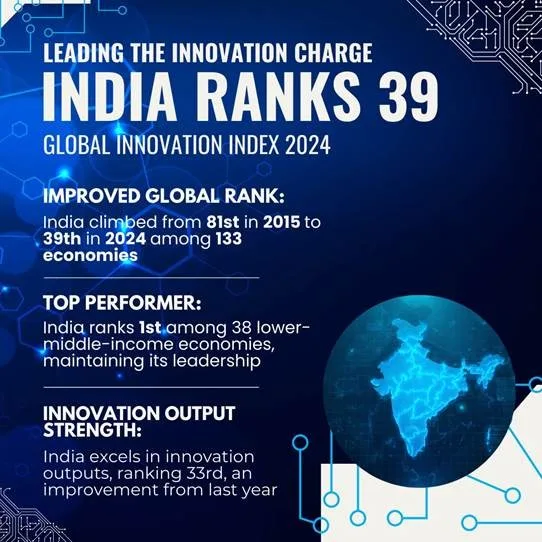Syllabus: GS3/Issues Relating To Intellectual Property Rights
Context
- Recently, the World Intellectual Property Organization (WIPO) released its World Intellectual Property Indicators (WIPI) Report 2024, highlighting significant trends and developments in global intellectual property (IP) filings.
Key Highlights of the WIPI Report 2024
- Global Growth in IP Filings: The report recorded a total of 3.55 million patent applications filed worldwide in 2023, marking a 2.7% increase from 2022.
- This growth was largely driven by residents in leading economies such as China, the United States, Japan, South Korea, and India.
- India’s Performance:
- Patents: India saw a remarkable 15.7% growth in patent applications in 2023, the highest among the top 20 origins. India now ranks 6th globally with 64,480 patent applications.
- Trademarks: India ranked 4th globally in trademark filings, with a 6.1% increase in 2023. Nearly 90% of these filings were by residents.
- Industrial Designs: India experienced a 36.4% rise in industrial design applications, reflecting growth in sectors like textiles, tools, and health.
- Resident Filings: For the first time, more than half (55.2%) of India’s patent applications were filed by residents, highlighting the country’s growing domestic innovation capabilities.
- Patent Grants: The number of patents granted in India increased by 149.4% in 2023 compared to the previous year, showcasing the country’s evolving IP ecosystem.
- Sectoral Contributions: Key sectors contributing to India’s IP filings include health, agriculture, and clothing for trademarks, and textiles, tools, and health for industrial designs.
India’s Impressive Leap in the Global Innovation Index 2024

- India has achieved a significant milestone in the Global Innovation Index (GII) 2024, securing the 39th position (81st position in 2015) among 133 global economies.
- It reflects India’s commitment to fostering a robust innovation ecosystem, underpinned by strong policies, investment in research and development (R&D), and a collaborative environment for startups and industries.
Innovation Outputs and Global Recognition
- India’s innovation outputs have seen substantial improvement, with the country ranking 33rd globally in this category. The nation also excels in intangible asset intensity, standing at 7th globally.
- Furthermore, India ranks 4th in the WIPO’s Science & Technology (S&T) Cluster Ranking, with cities like Mumbai, Delhi, Bengaluru, and Chennai listed among the world’s top 100 S&T clusters.
Economic Impact
- The rise in the GII rankings is not just a symbolic achievement; it has tangible economic implications. The innovation-driven growth has contributed to job creation, enhanced productivity, and overall economic development.
- The government’s emphasis on ease of doing business and technological advancement has further bolstered India’s position as a global innovation leader.
- IPR plays a crucial role in fostering innovation and creativity. In India, the framework for IPR is designed to protect the rights of creators and inventors, thereby promoting economic growth and cultural development.
- India has emerged as a key player, showcasing remarkable growth and innovation across patents, trademarks, and industrial designs.
Key Concerns Ahead of India’s IPR Regime
- Patent Backlog and Delays: One of the major issues is the backlog of patent applications and the lengthy time it takes to process them.
- It can hinder innovation and discourage inventors from filing patents in India.
- Enforcement of IPR: Effective enforcement of IPR laws remains a challenge.
- Despite having robust laws in place, the implementation and enforcement at the ground level are often inconsistent, leading to issues like piracy and counterfeiting.
- Awareness and Education: Many creators and inventors are unaware of how to protect their intellectual property.
- Striking a balance between protecting intellectual property and ensuring public access to essential goods, such as medicines, is a critical concern.
- Infrastructure and Resources related issues .
Government Initiatives
- The Indian government’s initiatives, such as the National Intellectual Property Rights (IPR) Policy, National Intellectual Property Awareness Mission (NIPAM), Atal Innovation Mission, Startup India and the Atmanirbhar Bharat campaign, have played a crucial role in fostering an innovation-friendly environment.
- These efforts have not only boosted IP filings but also contributed to economic growth.
- The patent-to-GDP ratio has seen a significant rise, indicating that IP activity is scaling alongside economic expansion.
- IP Commercialization: Establishment of Technology Innovation Support Centres (TISC) in universities to support IP filings and the commercialization of patents and other IP.
- Scheme for Pedagogy & Research in IPRs for Holistic Education and Academia (SPRIHA): It aims to integrate IPR education into higher learning institutions across the country. Under the SPRIHA scheme, IPR Chairs have been established in various universities and academic institutions to facilitate specialised research, teaching, and training in intellectual property.
Conclusion and Way Forward
- The robust IPR framework in India is essential for fostering innovation and creativity. By protecting the rights of creators and inventors, India can continue to grow economically and culturally.
- There is a need for greater awareness and education about IPR among businesses, especially small and medium enterprises (SMEs), and the general public.
- The infrastructure and resources available for IPR administration need significant improvement.
- To remain competitive on a global scale, India needs to continuously update its IPR policies to align with international standards and practices.
- It includes participating in global IPR treaties and agreements.
| Daily Mains Practice Question [Q] Discuss the factors that have contributed to India’s significant leap in the Global Innovation Index 2024. How can India further capitalise on this momentum to solidify its position as a global innovation hub? |
Previous article
GovAI: Reimagining Governance with AI
Next article
Declining Health Spending Risks SDG Goals